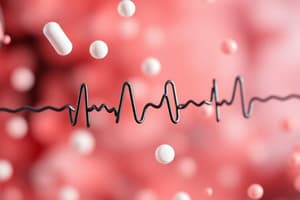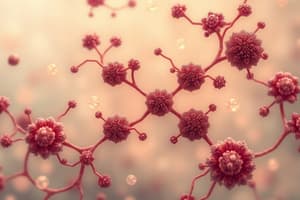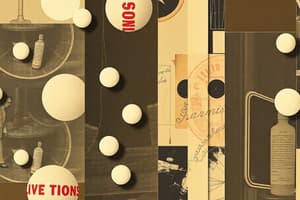Podcast
Questions and Answers
Which process describes how drugs enter the bloodstream?
Which process describes how drugs enter the bloodstream?
- Excretion
- Distribution
- Metabolism
- Absorption (correct)
What factor is not a major influence on a drug's distribution in the body?
What factor is not a major influence on a drug's distribution in the body?
- Lipophilicity vs. hydrophilicity
- Drug formulation (correct)
- Blood flow to tissues
- Drug binding to plasma proteins
What is the primary organ where drug metabolism occurs?
What is the primary organ where drug metabolism occurs?
- Lungs
- Liver (correct)
- Intestines
- Kidneys
Which term describes the elimination of drugs from the body?
Which term describes the elimination of drugs from the body?
Agonists are drugs that:
Agonists are drugs that:
What does the therapeutic index measure?
What does the therapeutic index measure?
Which term refers to the unintended effects of a drug?
Which term refers to the unintended effects of a drug?
Which of the following correctly defines potency?
Which of the following correctly defines potency?
What describes the relationship between a drug dose and its pharmacological effect?
What describes the relationship between a drug dose and its pharmacological effect?
Which type of drug specifically blocks receptors from activation?
Which type of drug specifically blocks receptors from activation?
What is a key factor that can influence individual drug responses due to genetic differences?
What is a key factor that can influence individual drug responses due to genetic differences?
Which mechanism of action involves blocking the activity of enzymes?
Which mechanism of action involves blocking the activity of enzymes?
Which of the following terms describes the maximum effect a drug can produce?
Which of the following terms describes the maximum effect a drug can produce?
What is the significance of a high Therapeutic Index (TI)?
What is the significance of a high Therapeutic Index (TI)?
How does aging typically affect pharmacodynamics?
How does aging typically affect pharmacodynamics?
What impact can co-administration of other drugs have on pharmacological effects?
What impact can co-administration of other drugs have on pharmacological effects?
Flashcards are hidden until you start studying
Study Notes
Pharmacokinetics
- Definition: The study of how drugs are absorbed, distributed, metabolized, and excreted in the body.
- Four Key Processes:
- Absorption:
- Process by which drugs enter the bloodstream.
- Factors influencing absorption:
- Route of administration (oral, intravenous, etc.)
- Drug formulation (liquids vs. solids)
- Gastrointestinal pH
- Distribution:
- Refers to how drugs disseminate throughout the body's tissues and fluids.
- Influencing factors:
- Blood flow to tissues (high in liver, kidneys, and heart)
- Drug binding to plasma proteins (e.g., albumin)
- Lipophilicity (fat solubility) vs. hydrophilicity (water solubility)
- Metabolism:
- Chemical alteration of a drug by the body, primarily in the liver.
- Phase I reactions: oxidation, reduction, hydrolysis.
- Phase II reactions: conjugation to enhance water solubility.
- Excretion:
- Elimination of drugs from the body, mainly via kidneys (urine).
- Other routes: bile (feces), sweat, saliva, and milk.
- Clearance: measure of the rate at which a drug is removed from the body.
- Absorption:
Pharmacodynamics
- Definition: The study of the effects of drugs on the body and the mechanisms of their action.
- Key Concepts:
- Drug-Receptor Interaction:
- Drugs exert effects by interacting with specific receptors (e.g., enzymes, hormones).
- Agonists: activate receptors to produce a response.
- Antagonists: block receptors, inhibiting a response.
- Dose-Response Relationship:
- Relationship between the dose of a drug and the magnitude of its effect.
- Potency: amount of drug needed to produce a specific effect.
- Efficacy: the maximum effect achievable by the drug.
- Therapeutic Index:
- Ratio measuring the safety of a drug.
- Calculated as TD50 (toxic dose for 50% of the population) / ED50 (effective dose for 50% of the population).
- Side Effects and Toxicity:
- Side effects are unintended effects, which can be mild or severe.
- Toxicity occurs when drug levels exceed the therapeutic range.
- Drug-Receptor Interaction:
Summary
- Pharmacokinetics and pharmacodynamics are foundational to understanding how drugs work in the body.
- Both fields explore different aspects of drug action and efficacy, which are crucial for safe and effective medication use.
Pharmacokinetics
- Study of how drugs move throughout the body
- Four main processes: absorption, distribution, metabolism, and excretion
- Absorption: How drugs enter the bloodstream
- Influenced by route of administration, formulation, and gastrointestinal pH
- Distribution: How drugs spread throughout the body
- Influenced by blood flow, drug binding to proteins, and drug solubility
- Drugs are more likely to go to areas with more blood flow (e.g., liver, kidneys, heart)
- Metabolism: Chemical changes the body makes to a drug, mainly in the liver
- Helps make drugs more water-soluble, which makes them easier to excrete
- Excretion: Removal of drugs from the body, primarily through the kidneys
- Excretion can also happen through bile, sweat, saliva, and milk
- Clearance measures how quickly a drug is removed from the body
Pharmacodynamics
- Study of how drugs affect the body and how they work
- Drug-receptor interaction: Drugs work by binding to specific receptors in the body
- Agonists: Activate receptors to produce a response
- Antagonists: Block receptors, preventing a response
- Dose-response relationship: Relationship between the amount of drug and the effect it produces
- Potency: The amount of drug needed to produce a specific effect
- Efficacy: The maximum effect a drug can produce
- Therapeutic index: A measure of drug safety
- Calculated by dividing the toxic dose for 50% of the population (TD50) by the effective dose for 50% of the population (ED50)
- Side effects and toxicity:
- Side effects are unintended effects of drugs
- Toxicity occurs when drug levels are too high
Summary
- Pharmacokinetics and pharmacodynamics are important for understanding how drugs work
- They help explain how drugs are absorbed, distributed, metabolized, and excreted (pharmacokinetics)
- They also explain how drugs interact with the body to produce their effects (pharmacodynamics)
Pharmacodynamics
- The study of how drugs interact with living systems to produce effects
- Drugs exert their actions by binding to specific receptors in the body
- Agonists activate receptors and produce biological responses
- Antagonists block receptors and prevent biological responses
- Dose-response relationship describes the correlation between drug dose and its effect
- The threshold dose is the minimum amount of drug required to elicit a measurable effect
- Efficacy refers to the maximum effect the drug can produce
- Potency denotes the amount of drug needed to achieve a specific effect
- Drug actions can involve various mechanisms including enzyme inhibition, modulation of ion channels, and interaction with transporters
- Therapeutic index (TI) measures drug safety and is the ratio between toxic dose and effective dose
- A higher TI indicates a safer drug with a wider margin between effective and toxic doses
- Pharmacogenetics studies how genetic variations influence individual drug responses
- Variations in drug metabolism can affect efficacy and toxicity among patients
- Factors like age, gender, disease state, and drug interactions can significantly influence pharmacodynamics
- Understanding pharmacodynamics is crucial for accurate dose selection, predicting drug interactions, and maximizing therapeutic outcomes
Studying That Suits You
Use AI to generate personalized quizzes and flashcards to suit your learning preferences.





